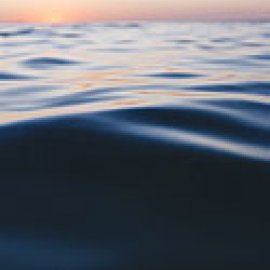How Old Is Water?
-
English
-
ListenPause
Intro music
Welcome to World Ocean Radio…
I’m Peter Neill, Director of the World Ocean Observatory.
How old is water? Where on earth is water found?
The answers are inevitable complicated. Let’s simplify:
Scientists appear to agree that water was not natural to our planet and was introduced some 4.5 billion years ago by planetary collision in space, delivered by asteroids and solar wind.
Water is located by percentage as follows: Oceans, Seas and Bays: 96.54%; Ice Caps, Glaciers, and Permanent Snow: 1.74%; Groundwater (Fresh) 0.76%; Groundwater (Saline) 0.93%; Soil Moisture: 0.001%; Ground Ice and Permafrost: 0.022%; Lakes (Fresh) 0.007%; Lakes (Saline) 0.006%; Atmosphere: 0.001%; Swamp Water: 0.0008%; Rivers: 0.002%; and Biological Water: 0.0001%.
What is “biological water?” you might ask. It is the water that exists in all living things, including the human body comprised 60% by water, about 40 liters, without which we cannot survive.
Water is constantly in circulation through the water cycle, although the residence time, its status in any given location, varies: in the atmosphere, for example, 7 to 9 days, in the ocean, 3,000 to 3,500 years. Water in all its dynamic iterations is finite in volume; its utility is constant, except when it is rendered polluted, and, while still within the system, becomes toxic to life.
When we speak of a water crisis, we are observing the negative curve of the cycle. Climate-induced drought, for example, accelerates evaporation in one place with dire consequence, but that water is recycled and redistributed elsewhere where it too is needed and beneficial. We are immersed in water conflict, reduced to water wars and lethal attacks on our neighbors for access to wells and groundwater supplies to provide water for our manufacture, our fields, our communities, and ourselves.
It is when we pollute water, with chemicals and emissions, with fracking and indiscriminate industrial use, that we reduce the finite amount, not by volume but by its essential utility. Fertilizer run-off, point-source and wastewater discharge, and energy generated emissions that acidify our coastal areas and deep-water ocean—these become accelerated and, distributed by natural global systems, that changes the pH and kills ocean coral, that enters our bodies through consumption of poisoned freshwater, air, meat and plant products, and fish that attack our bodies through expanded and new infections and disease.
Scientists estimate that today one in four people on earth—some 2.2 billion—do not have access to safe drinking water, and that such unsafe water accounts for one million deaths per annum. According to a 2020 UN Report, roughly half of the world’s population experiences severe water scarcity for at least part of the year; water deficits are linked to a 10% increase in global migration between 1970–2000; in lower-income countries, poor water quality is due to low levels of wastewater treatment, whereas in higher-income countries, runoff from agriculture poses the most serious problem; emerging contaminants that include pharmaceuticals, hormones, industrial chemicals, detergents, per- and poly-fluoroalkyl substances (PFAS) and nanomaterials; and floods and drought persist as the most devastating water-related disasters, between 2002–2021, floods caused nearly 100,000 deaths per annum, affecting another 1.6 billion people, and causing US$832 billion in economic losses.
The statistics are mind-numbing, and seemingly don’t pertain to you and me. But they do. We must now test our wells and the condition of our gardens and fields; investigate how the quality and price of imported foods and manufactured goods might be affected by these conditions; understand how the decline of drinking water and irrigation supplies in India, and Mexico, and the southwestern United States have repercussions that are real and disruptive to what we consider the natural order of things.
Water is old. But there is no new water to replace that which we destroy. What happens if there is no water? As a planet, we would dry out and die. As a community, we would gather and mourn…unless, as individuals and nation states , we declare a new water ethic, a mandate built around the understanding that confirms water as the Universal Healer, elementary and essential, not just for personal health and collective welfare, but for survival as the singular, most essential physical, political, and psychological element of our lives, finite and eternal.
We will discuss these issues, and more, in future editions of World Ocean Radio.
[Outro music]
In celebration of World Water Day on March 22nd, World Ocean Radio is revisiting some favorite episodes dedicated to fresh water and the global water cycle. This week: How old is water? Where on earth is water found? How is it circulated, cycled, and recycled? We know where water is distributed on the planet down to the fraction of a percentage. We know that water is finite in volume and its utility is constant. What happens when we pollute water? What happens when there is no water?
About World Ocean Radio
World Ocean Radio is a weekly series of five-minute audio essays available for syndicated use at no cost by college and community radio stations worldwide. Peter Neill, Director of the World Ocean Observatory and host of World Ocean Radio, provides coverage of a broad spectrum of ocean issues from science and education to advocacy and exemplary projects.
World Ocean Radio
15 Years, 750 Episodes
Ocean is climate
Climate is ocean
The sea connects all things
- Login to post comments



